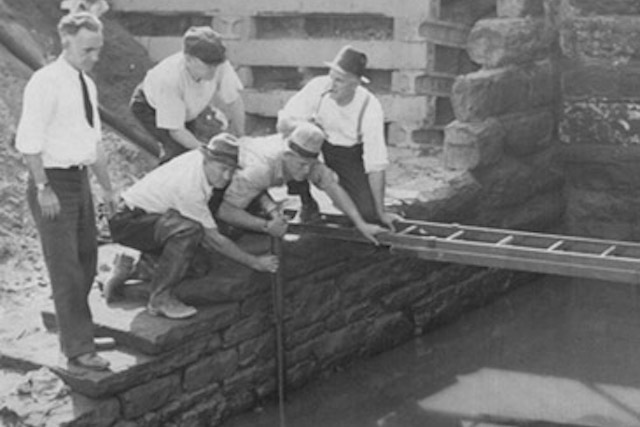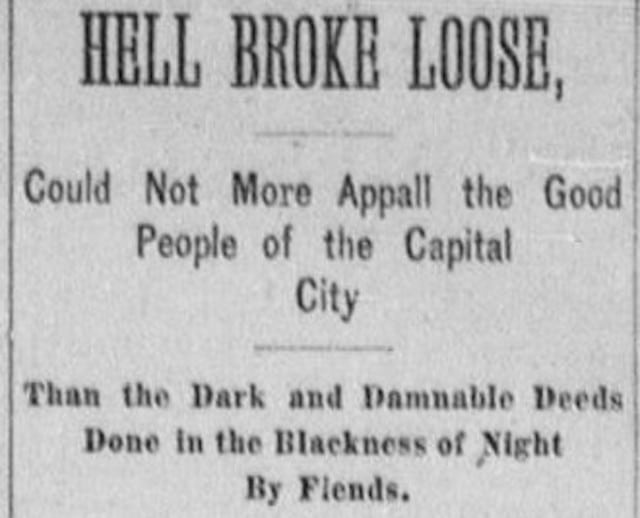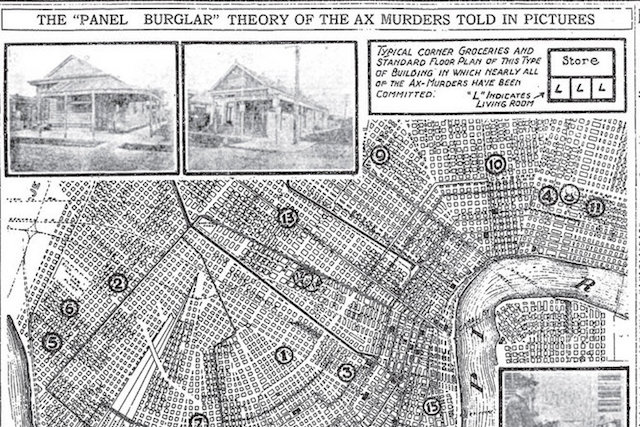Everybody has heard of Jack the Ripper. Everybody has heard of the Zodiac. The fact that they have never been caught, or even identified, only helped build their notoriety.
They might be two famous examples, but they are not unique ones, by any means. We are going to take a look at 10 other cases where vicious, gruesome, bloodthirsty serial killers have managed to evade justice.
10. The Mad Butcher of Kingsbury Run

During the mid-to-late 1930s, Cleveland, Ohio, was home to a cold-blooded, vicious maniac who liked to go around dismembering people, dumping most of their remains in a poor neighborhood of the city called Kingsbury Run. Because of this, he is known as the Mad Butcher of Kingsbury Run, although he is also commonly referred to as the Cleveland Torso Murderer.
Around a dozen murders are confidently ascribed to the Mad Butcher, although only two of the victims were ever identified. There are a few more that could possibly be blamed on him, especially if you agree with the theory that around 1939 he left Cleveland and started killing someplace else.
Besides the obvious gruesomeness of the murders, the case of the Mad Butcher also gained notoriety due to the involvement of Eliot Ness, leader of the Untouchables. After his work taking down Al Capone, Ness accepted the position of Cleveland Public Safety Director, which gave him direct authority over the police and fire departments. Although Ness mainly delegated, and rarely took an active role in the investigation, the killer might have taunted him directly by placing the bodies of the last two victims in plain view of his office window.
The police had one strong suspect, but they were never able to build a case against him, partly due to lack of evidence, partly due to political interference. He remains one of America’s most infamous unidentified killers, and if you would like an in-depth look at the Mad Butcher, we’ve done a full video on him on our sister channel, Biographics.
9. The West Mesa Bone Collector
The West Mesa is a stretch of land, mainly undeveloped, located between the cities of Albuquerque and Bernalillo, New Mexico. Back in 2009, a woman was walking her dog in that area when they made a ghastly discovery – a human bone. She reported it to the police, who went out there expecting to find the remains of a person. They didn’t. Instead, they uncovered the remains of 11 people, as they seemingly stumbled upon the dumping grounds of a serial killer.
After about a year of investigations, New Mexico authorities identified all the victims. They were women ranging between 15 and 32 years of age and almost all of them had previous arrests for drugs or prostitution. Only one of them was from out of state, and they all went missing between 2001 and 2005. Although the cause of death for all of them was listed as “homicidal violence,” evidence was too scarce to determine how they were actually killed.
The murders have largely been attributed to a single culprit dubbed the West Mesa Bone Collector. If police have made any serious progress in the case in the last decade, they have kept that information confidential. There have been a few plausible suspects, such as a local photographer or a serial killer convicted for other murders, but the case remains officially open.
8. The Paraquat Murders
Let’s try and set the scene – we’re in Japan, in 1985. It’s late spring so it’s hot outside. You’re walking down the street and you get thirsty. You stop by a vending machine and you see a bottle already inside the tray or sitting on top of the machine. It looks sealed so you figure that it is probably safe, most likely left there by a good samaritan who got an extra bottle by accident. You open it and you drink it. Soon enough, you start feeling very sick, and you might even die because you have just been poisoned.
This was the scenario that unfolded dozens of times in Japan over a roughly six-month period. Somebody was lacing beverages with a deadly herbicide called paraquat and leaving them out for unsuspecting passers-by. The drink of choice was a vitamin-enriched juice called Oronamin C, although others were also used.
Around 50 people were poisoned this way, and at least 10 of them died. It is usually believed that one person was responsible for most, if not all the poisonings, although the crime spree did later lead to several copycats. Japan is usually very secretive when it comes to active investigations, but it seems that no arrests were ever made in the case.
7. The Servant Girl Annihilator

We are traveling back in time to the mid-1880s for this one, when a crazed axe murderer was targeting women in Austin, Texas. He was called the Servant Girl Annihilator, a name coined by the writer O. Henry, and he became one of America’s first-known serial killers.
The culprit liked to attack his victims in bed, and drag them outside wounded and dazed, but still alive. That is where he killed them, posed them and, sometimes, mutilated their bodies. Despite what his name might suggest, he did not exclusively target servant girls, or even women, for that matter. Sometimes he attacked couples and, on one occasion, he attacked a young girl. He killed eight people in a one-year time period between 1884 and 1885, and at least six more were left seriously wounded after a visit from the Annihilator. Afterwards, he simply vanished without a trace.
Dozens of hypotheses regarding his identity were put forward, but the most interesting one asserts that the Annihilator left Texas in 1886 and traveled to London, where he resumed his killing spree a couple of years later under the name Jack the Ripper.
6. The Bowraville Murders
We’re moving on to Australia, to a series of three murders that occurred in late 1990 in Bowraville, New South Wales.
The victims were varied – one was a teenage boy, the other a teenage girl, and the third was a four-year-old child. Even so, there were enough similarities between the killings that convinced authorities that they were the work of the same person: they all happened in the same small town, within a short time frame. All the victims were Aboriginal, they disappeared after parties, and the two whose remains were found were both killed with blows to the head.
In this case, the problem has not been finding a suspect, but prosecuting him. A 25-year-old local was charged with one of the murder all the way back in 1991. He was acquitted in 1994, following a sloppy investigation that was allegedly tainted by police prejudice against Aboriginals. He was charged with one of the other killings in 2006 and, again, acquitted. Ever since then, the detectives working the case, the victims’ families, and the New South Wales Attorney General have been campaigning for a retrial, based on new evidence, but the criminal courts have denied the request several times due to the state’s double jeopardy laws, and unless those change, it is unlikely that any more progress will be made in the case.
5. The Long Island Serial Killer
Like the case in the West Mesa, the crimes of this killer from Long Island went unnoticed for years until a chance discovery of the place where he dumped the remains of his victims. In 2010, while looking for the body of a prostitute who had recently gone missing, Suffolk County police found the body of a woman near Gilgo Beach.
The victim matched the description closely, but she turned out to be someone else entirely. Searchers went out there again and found another body. And then another one…and another one. As they combed the Ocean Parkway that passes through Long Island, authorities discovered the remains of ten people, most of them young women who worked as escorts and used Craigslist to find clients. Because of this, the media has called the culprit the Craigslist Ripper, but he is also known as the Gilgo Beach Killer, the Long Island Serial Killer, and LISK.
He has been active for at least 15 years, between 1996 and 2010, and has probably killed around 10 people, although not everybody is convinced that he is responsible for all the bodies recovered from the Gilgo Beach area.
As far as his identity is concerned, a few suspects have been put forward, but the strongest candidate is a carpenter who lived in the area named John Bittrolff, who is a serial killer in his own right and has already been convicted for two other murders.
4. The Colonial Parkway Murders
The Colonial Parkway is a very scenic road that connects some of Virginia’s most significant historical landmarks. You might think that it would make the ideal location where young couples could take a nice, romantic drive, but this was not the case during the late 1980s, because it was also the hunting grounds of a deadly predator.
The killings resembled those of the Zodiac. The culprit approached couples who had parked in lover’s lanes, restrained them with ropes and usually killed them either by stabbing or strangulation. The victims did not display any signs of sexual assault. However, this killer did sometimes try to get rid of the bodies, while the Zodiac always made sure that they were found and that he was given credit for them.
Three couples were killed this way between 1986 and 1989. A fourth one is missing and presumed dead. Around 150 suspects were questioned in connection to the murders, but no arrests have been made so far.
3. The Monster of Florence
In 1968, a couple was shot to death in their parked car in a small town outside of Florence, Italy. They had been having an affair. The woman was married to someone else so, unsurprisingly, her husband became the main suspect. The Italian police built a case against him and the man was convicted and sentenced to 14 years in prison.
At first, this might have seemed like an expected outcome for a love triangle, but then something else happened – another couple was killed six years later, in 1974. This time, not only had they been shot, but the female victim had also been mutilated with a knife. And they were followed by two more couples killed in 1981, and four more couples after that.
The Monster of Florence, as he had been dubbed by the media, had murdered 14 to 16 people, depending on the source. Besides the similar targets, killing method, and mutilation of the female victims, there is another characteristic that has convinced Italian authorities that the same person is responsible for all the murders – they were shot with the same gun. It is a Beretta .22 caliber that produced a distinctive mark on the shell casings due to a defective firing pin.
During the 1990s, police thought they had found their culprit – a man with a history of violence and physical abuse, who had already stabbed another man to death during the early 1950s. His name was Pietro Pacciani, and he was actually found guilty in 1994, but the verdict was overturned in 1996. Pacciani died of a heart attack two years later, before a new trial could start. Some are still convinced he was the killer, but the Monster of Florence has never been officially identified.
2. The I-70 Killer
In the spring of 1992, a murderer traveled through the Midwest of America, leaving a string of bodies behind him. He became known as the I-70 Killer because he targeted small, remote stores located off of Interstate 70, shooting the clerks who mistook him for a customer.
Sometimes he also robbed the place, sometimes he didn’t. Money did not appear to be a heavy motivator for him, instead it was more about the victim. He clearly had a preference – five of the six people he killed were all young brunettes. The sixth one was actually a man named Michael Michael McCown who owned a ceramics shop. Because McCown had long hair worn in a ponytail, police suspected that the I-70 Killer initially mistook him for a woman from a distance, and by the time he had gotten close enough to realize the truth, it was already too late to back out.
Six people fell victim to the I-70 Killer between April and May, 1992, in Indiana, Missouri, and Kansas. Two more murders committed in Texas in the following years were tentatively ascribed to the same killer, but a definitive connection has not been established yet. A witness saw him after his attack on a bridal shop in Wichita. This resulted in a few sketches, but no suspects have ever been publicly named and the I-70 Killer remains at large.
1. The Axeman of New Orleans

March 19, 1919, is an infamous day in the history of New Orleans. It was on that night that most of the city’s residents crammed themselves into cafés, bars, and dance halls and partied until dawn while listening to swinging jazz music. Did they want to do this? No, they did it out of fear, in order to please a murderous maniac walking among them who, otherwise, might have targeted them as his new victims.
He became known as the Axeman of New Orleans and he was, as the police superintendent described him, a “murderous degenerate … who gloats over blood.” He broke into people’s homes at night and attacked them with axes and knives. Most of his victims were grocers and their families, and all of them were Italian immigrants. He assaulted 12 people this way – six died, six survived.
And yet, that is not the most infamous aspect of this crime spree. No, that happened when the local Times-Picayune newspaper received and published a letter supposedly from the Axeman. It was dated March 13, 1919, from “Hottest Hell.” Besides detailing his delight for murder and mocking the police for their inability to catch him, the Axeman also expressed his fondness for jazz music. He then gave the city of New Orleans a warning – that at 12:15, the next Tuesday night, he would be out on the prowl. The houses playing jazz music would be spared. Those that did not “will get the axe.”
Nobody was killed that night as the city “jazzed it out,” per the Axeman’s demand. He did attack three more times in the following months, before disappearing forever. The identity of the Axeman of New Orleans remains a mystery today.